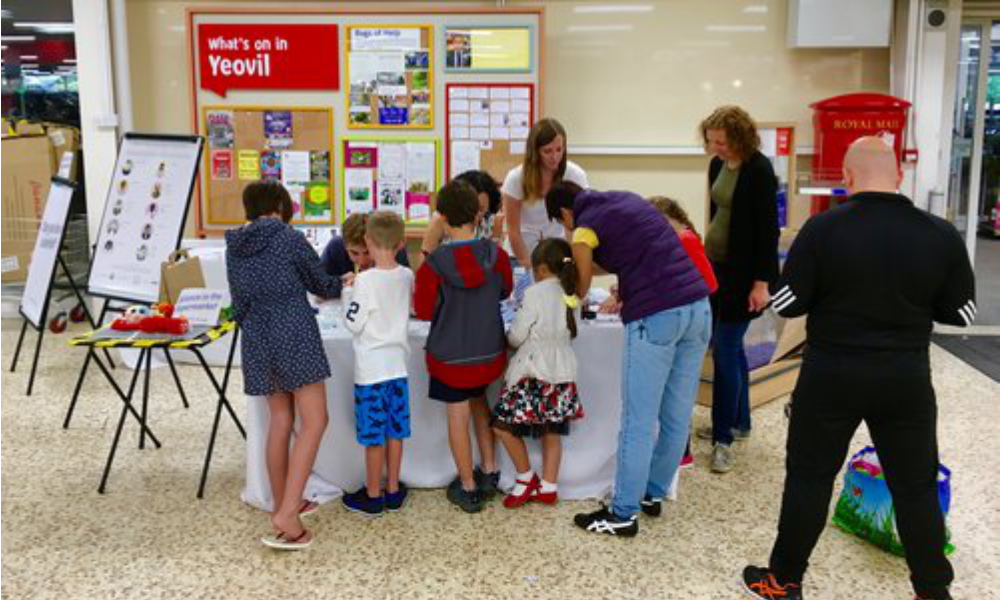Science in the Supermarket
Science in the Supermarket was an engagement project to promote studying STEM subjects to young families in the West Country.
The project was funded by Imperial College London's Societal Engagement Seed Fund.
Target audience
The campaign targeted families with low science capital to promote the acceptance rates of students from these backgrounds into higher-education programmes. Science capital is a concept developed through the ASPIRES research project into young people’s aspirations, and is defined as “science-related qualifications, understanding, knowledge (about science and ‘how it works’), interest and social contacts (e.g. knowing someone who works in a science-related job)”.1
The target audience was 8-12-year-olds, living in the Somerset area, from family backgrounds with low science capital. However, rather than directly targeting this demographic, the project focused on reaching the parents and families of these children. The rationale for this approach was supported by previous reporting and research in relevant areas:
-
by secondary school age interventions have less meaningful impact on students’ aspirations,1
-
parents and familial background are major influences of students’ career choices and aspirations,2 with students from low science capital backgrounds less likely to aspire to STEM related careers.1
-
research by the Behavioural Insights Team, and the Somerset Challenge found that young people from schools in Somerset are “less likely to attend university despite having good A-level results”,3
-
university application rates from the South West continue to decline relative to the national average,4 with Somerset containing multiple wards with the lowest participation rates in higher education (POLAR4 quintile 1 HEFCE classification).5 6 Applicants from lower participation regions are less likely to receive offers to study at Imperial,7 and are under-represented within the student body,8
-
Somerset is relatively isolated due to its distance from HE providers,9 which is a barrier to existing engagement and outreach programmes.
Methods
The project aimed to achieve its primary objective by:
-
running a trial engagement stand in a supermarket(s) across Somerset over one weekend (two days’ total) during Spring 2018,
-
recruiting four volunteers from the Imperial community, in particular those with existing links to the Westcountry, to operate the stand,
-
promoting the event to local media (print, radio, television), in the target areas,
-
working with the volunteers ahead of the visit to find interesting artefacts and/or develop relevant demonstrations related to their role,
-
using the artefacts/demonstrations both to engage children, and facilitate more in-depth conversations with parents (for example: blowing bubbles to represent cell membrane, allowing the child to play while chatting to parents/guardians),
-
providing A5 information cards to distribute to parents, detailing:
-
simplified case-studies of successful scientists and technicians (ideally from the West Country, or of similar rural background),
-
links to further engagement resources and/or opportunities in the South-West via a central campaign website,
-
incorporating a sticker wall, featuring different STEM roles (including different types of scientists and technicians), which challenges children to pick the role they would most like to be. This document represents the final report and evaluation for this project. It was created to bring together the findings of the two-day trial, to guide future continuation of this project. It is made available as a reference for others interested in carrying out similar engagement activities.
Read the full project report here
-
ASPIRES, “ASPIRES: Young people’s science and career aspirations, age 10 – 14” (London, 2013), Internet Archive Link. ↩↩↩
-
A. MacDonald, “‘Not for people like me?’ Under-represented groups in science, technology and engineering” (2014), Internet Archive Link. ↩
-
Behavioural Insights Team, “Behavioural Insights and the Somerset Challenge” (London, 2015), Internet Archive Link. ↩
-
UCAS, UK application rates by the January deadline. 2016 cycle (2016), Internet Archive Link. ↩
-
HEFCE, POLAR – Participation of Local Areas (2017), Internet Archive Link. ↩
-
HEFCE, “Further information on POLAR3: An analysis of geography, disadvantage and entrants to higher education” (2014), (available at http://dera.ioe.ac.uk/19292/1/HEFCE2014_01.pdf). ↩
-
UCAS, “Imperial College London - 2016 Sex, area background and ethnic group” (2016), (available at https://www.ucas.com/files/imperial-college-london-2016-sex-area-background-and-ethnic-group). ↩
-
HESA, “Widening participation summary: UK Performance Indicators 2015/16” (2017), (available at https://www.hesa.ac.uk/data-and-analysis/performance-indicators/widening-participation-summary). ↩
-
HEFCE, Higher education provision in England pre-2015 (2014), Internet Archive Link. ↩
